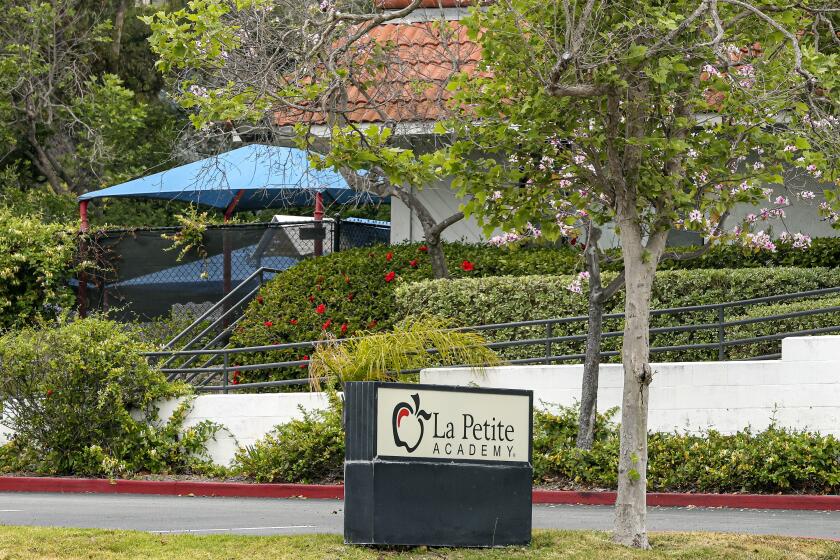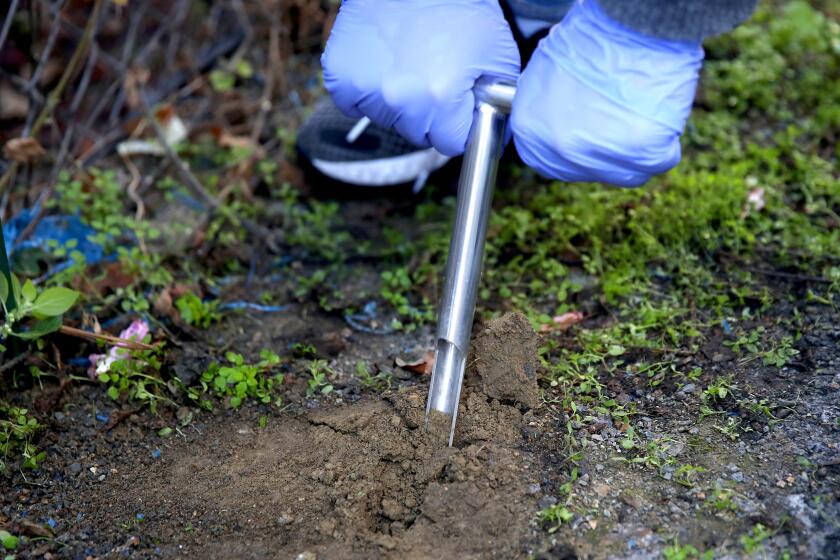California lawmakers pass bill requiring schools to test for lead in drinking water

- Share via
California lawmakers have passed a bill that would require kindergarten-to-12th-grade schools in the Golden State to test for brain-damaging lead in all drinking water outlets.
Assembly Bill 249 would require community water systems that serve schools built before 2010 to test all potable water outlets for lead, and to report results to the school, educational agency and state water regulators. Outlets exceeding lead levels of 5 parts per billion would have to be shut down immediately. Testing would be required before 2027, and would also apply to preschools and child day care facilities on public school property.
The measure, authored by Assemblymember Chris Holden (D-Pasadena), passed in the Senate and the Assembly this week. It now heads to Gov. Gavin Newsom’s desk for a final decision.
The legislation comes on the heels of alarming data revealing that one in four of the state’s child-care centers has dangerously high levels of lead in their drinking water, suggesting that thousands of infants, toddlers and children are being exposed to the potent neurotoxin.
The highest results came from a facility in San Diego that recorded 11,300 parts per billion at the time of testing — well above the state’s limit of 5 ppb in child-care centers.
Results of newly mandated testing reveal that nearly 1,700 child-care centers across the state have dangerous levels of lead in their drinking water.
If lead levels are exceeded, the bill requires schools or educational agencies to notify parents and guardians, shut down the outlet, and find an alternative source of lead-free drinking water. Results of the lead sampling would have to be publicly available online. Schools or educational agencies would need to provide results upon request if they lack a website.
Schools that have replaced all potable water outlets as part of a modernization that occurred after 2010 would be exempt from testing.
The Senate Appropriations Committee estimated the law would cost the California State Water Resources Control Board in the low tens of millions of dollars in the first years, and millions annually thereafter, money that would come from the general fund or a special fund. The cost would include the development and implementation of a new data collection system, database maintenance and data quality control oversight, inspection of facilities, and responding to complaints and levels that exceeded limits, among other things.
The committee estimated “potentially significant one-time costs” for districts or other educational agencies to remediate lead pollution if it is found.
The bill was co-sponsored by the Environmental Working Group and Children Now, a nonprofit focused on children’s health.
Several major groups expressed opposition to the bill.
The Assn. of California School Administrators and the California Assn. of School Business Officials argued, among other things, that immediately shutting off outlets that exceed the lead standard could leave an entire school without potable water for a prolonged time. They added that intermediate responses, such as flushing water for 30 seconds, have proved to lower lead levels, and that exemptions should be made for schools that have installed water filtration systems.
The California Municipal Utilities Assn., which represents over 50 agencies that supply water to 75% of state residents, and the California Special Districts Assn., which represents nearly 1,000 independent special districts, said that while they agree with the author’s goals, the bill “could result in duplication or conflict with pending federal requirements.”
They argued that the Environmental Protection Agency’s revised Lead and Copper Rule, which for the first time includes testing in schools and child-care facilities, would overlap with the bill’s current compliance date.
Numerous homes that underwent remediation have been left with lead concentrations in excess of state health standards, according to USC researchers.
“[W]ater systems likely would have to comply with two comprehensive testing regimes without any additional public health benefit,” they said in a joint letter. “And if the state law and federal law conflict, it is unclear how water systems would be expected to fulfill both sets of requirements.”
To avoid duplicate testing, the State Water Board would provide, among other things, application waivers to schools or water systems from having to also comply with federal requirements.
AB 249 is an echo of a similar bill enacted in 2017. AB 746 required water systems serving schools built before 2010 to test for lead in potable faucets, but the action level was higher, at 15 ppb, and it did not specify the number of outlets where testing was required.
The drinking water data released in May by the state Department of Social Services marked the first time in state history that child-care facilities have been required to test for lead, a law that was also authored by Holden and passed in 2018.
Lead is a particularly serious threat to children and pregnant people. According to the Centers for Disease Control and Prevention, there is no safe level of lead exposure in children, and that even at low levels, ingestion can lower a child’s IQ, impair their development and hearing, contribute to learning and behavior problems, and damage their brains and nervous systems. Lead in drinking water cannot be seen or tasted, and damage from lead poisoning is irreversible.
The metal commonly enters drinking water through lead fixtures, faucets and pipes, which are likely to be found in older homes and buildings built before 1986, according to the Environmental Protection Agency. Lead can also enter drinking water when plumbing materials that contain the metal corrode.
The EPA estimates that as much as 20% of a child’s exposure to lead comes from drinking water.
Lead exposure among children is also borne unequally. Low-income families and people of color are more likely to live in communities with old and aging infrastructure, according to the CDC, and children from disadvantaged neighborhoods also bear the cumulative effects of other pollutants and malnutrition, and attend under-resourced schools.
More to Read
Sign up for Essential California
The most important California stories and recommendations in your inbox every morning.
You may occasionally receive promotional content from the Los Angeles Times.
















